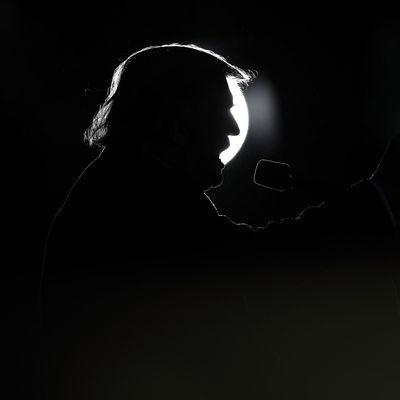
Long before this week, when he referred to himself as the victim of a lynching, Donald Trump has been fluent in the language of a racist mob. It ran underneath the full-page newspaper ads he paid $85,000 for in 1989, in which he called for the execution of the five black teens about to be tried for the rape of a white female jogger in Central Park. In that ad, he fretted for families who could no longer enjoy strolls in the park thanks to the presence of “wild criminals” roaming the streets. “I am not looking to psychoanalyze or understand [these men],” Trump wrote. “I am looking to punish them … I want them to understand our anger. I want them to be afraid.”
The anger Trump wanted these kids — who would spend 13 years in jail before being fully exonerated in 2002 — and the public to understand was the anger of a powerful white New Yorker who did not want to tolerate the presence of less powerful New Yorkers. More than that, he wanted millions of readers to understand the potency of that anger: its money, its influence, its public reach, its ability to cast the mere presence of people he didn’t like on the street as a violent threat to him and others like him.
These were the dynamics — fury at any disruption to his presence or preferences in the world, or to a social order which would keep him at the top — that Trump was so adept at conveying on a campaign trail in 2016, when he encouraged his massive, screaming, mostly white crowds to enact physical violence against any protesters who might take up space or challenge them. After one Black Lives Matter protester was beaten following one of his events, Trump told Fox News, “Maybe he should have been roughed up, because it was absolutely disgusting what he was doing.” At another rally, in Las Vegas, Trump told his jeering crowd, as a man was led out by police, “You know what they used to do to a guy like that in a place like this? They’d be carried out on a stretcher, folks.”
These calls echo the language and thinking of lynching, the extrajudicial torture and murder of mostly nonwhite people, and especially African-Americans, that was most common in the Jim Crow South. According to the King Center in Atlanta, “More than 4,400 African-American men, women, and children were hanged, burned alive, shot, drowned, and beaten to death by white mobs between 1877 and 1950.” This is the greatness of American history to which Trump has promised his fans a return; these are the flames he has consciously stoked: the return of the mob, and with it the ability, via public spectacle, to punish and hurt those with less power who would challenge or inconvenience an old kind of authority. The cruelty, as Adam Serwer has written, is the point. Yet when Trump is leading the mob, he is rarely fully explicit in his evocation of an era of racist violence.
On Tuesday, he made his reference plain, at the moment that he decided to reverse the lynching framework by casting himself, and imagined future Republican presidents, as powerless victims of a punitive Democratic crowd. “So some day, if a Democrat becomes President and the Republicans win the House, even by a tiny margin,” Trump tweeted, “they can impeach the President, without due process or fairness or any legal rights. All Republicans must remember what they are witnessing here – a lynching. But we will WIN!”
This was the text of Trump’s barely cogent missive, which not only made the vile comparison between a House impeachment inquiry and extrajudicial murder, but was also inaccurate in its assessment of congressional power dynamics and everything else, including spelling. Tactically, this gambit was not so different from Trump’s previous claims that he was victim of mobs and witch hunts, but when he used the word “lynching” outright, it was too much even for a couple of his party peers, including Mitch McConnell and Susan Collins, both of whom offered (extremely) tepid rebukes.
Yet it was just the thing for some other Republicans, chief among them South Carolina senator Lindsey Graham, who wasted no time getting in front of news cameras: “When [an investigation is] about Trump,” Graham said, claiming to describe the Democrats’ approach to impeachment, “who cares about the process, so long as you get him. So yeah, this is a lynching.” In case anyone wasn’t clear, Graham also said, “This is a lynching in every sense,” and later told Bob Costa, “If [the word] lynching bothers you, I’m sorry … it’s literally a political lynching.”
The willingness to abuse power and then protect one’s power by casting oneself as abused, via a fantasy of victimhood, surely has a lengthy history, but has become a particular hallmark of the post-Obama political era. The inversion of vulnerability so that it applies — nonsensically, ahistorically, yes, but too often, persuasively — to the least vulnerable is pervasive and effective. Those who were lynched were, definitionally, powerless. This makes it both particularly rich and particularly potent imagery for the powerful. It enables them to appropriate one of the only tools available to the powerless: the moral claim to a tale of injustice. Often, and often more subtly than how it unfolded on Tuesday, we are seduced by those with the loudest voices into seeing them — the most mighty — as the most mistreated.
Trump and Graham are not even the first politicians this year to compare the experience of public censure in response to alleged abuses to being lynched. Virginia’s lieutenant governor Justin Fairfax, a Democrat who in 2019 was accused on the record by two women of sexual assault, gave a speech in front of the Virginia State Senate in February in which he compared himself to a lynching victim. And it’s not just elected officials. In 2018, the musician R. Kelly, who has since been indicted on ten counts of aggravated criminal sexual abuse against minors, claimed that the Time’s Up Women of Color Branch, which was then advocating a boycott of his music, was tantamount to the “attempted public lynching of a black man who has made extraordinary contributions to our culture.” That “public lynching” is the same language that Bill Cosby’s publicist used about his conviction on sexual-assault charges in 2018; Cosby’s wife, Camille, wrote a three-page statement comparing her husband’s treatment to lynching. And one of the most famous uses of the lynching metaphor as defense of power came from Supreme Court Justice Clarence Thomas, who asserted in 1991 that the accusations of sexual harassment made against him by Anita Hill (and corroborated by three other women who were not asked to testify at his Judiciary Committee hearing) constituted a “high-tech lynching.”
Thomas, Cosby, Kelly, and Fairfax’s use of the lynching comparison is different than Trump’s; they are black men, recognizing in the metaphor its very real history, in which (mostly fantasized or invented) claims of sexual aggressions against white women were used to justify the torture and murder of black men. These men deployed the analogy in the face of multiple, credible allegations lodged against them, strategically using the history of racist violence as a shield, while in all cases except Cosby’s, these men’s accusers were primarily black women. (This is crucial, as Salamishah Tillet has argued, citing the journalist and anti-lynching activist Ida B. Wells, because while white women’s sexual violability has too often been used as the justification for racist violence, the very real sexual violence done to black women has just as often gone not only unpunished, but unnoticed).
None of this particular subtext applies to either Donald Trump or Lindsey Graham, both of whom are white men. Nor does it apply to the many lawmakers, including current Democratic presidential candidate Joe Biden, who defended Bill Clinton during his 1998 impeachment proceedings by comparing that inquiry to a lynching (a “partisan lynching,” was Biden’s phrase). What they all have in common is a readiness to turn to a metaphor that erases their power, when charged with abusing it, and presents them instead as the real victims of injustice.
Trump has repeatedly called the investigations into him — by special counsel Robert Mueller and now House oversight panels — a “witch hunt,” and Trump’s private counsel Rudy Giuliani tweeted that “Even Salem witch trials didn’t use anonymous testimony.” The reference to a period of 17th-century violence in Salem, Massachusetts, carries far less historical weight than the callback to lynching — a widespread practice that was common for decades and arguably extends to this day. But it relies on the same strategy: the pretense of defenselessness against a mob. Giuliani, appearing on Fox News with Laura Ingraham, would double down on his preposterous witch-trial assertion, telling her that the women and men accused of sorcery in 1692 Salem “had more rights” than President Donald Trump in 2019. (For what it’s worth, many of the women and men who were imprisoned, tortured, and killed in the 17th century were convicted based on “spectral evidence,” i.e., the testimony of spirits who appeared to random people sitting in the courtroom.)
The performance of inequity and injustice invites the public to view the powerful with a kind of sympathy that, ironically enough, is rarely available to those who have less power. This is the truly grotesque factor: It is power itself that renders people recognizable to us, affords them our sympathy and empathy; it’s power that makes them more likely to be believed when they tell us of the injustice they have suffered.
This is why Brett Kavanaugh, a wealthy white federal judge who was credibly accused of sexual violence yet was nonetheless elevated to the most powerful court in the country, managed to so successfully present himself to the nation as mortally imperiled. “My family and my name have been totally and permanently destroyed,” Kavanaugh said, while Trump postulated that “it’s a very scary & dangerous time for young men in America,” describing those who opposed Kavanaugh’s appointment as a “liberal mob” and suggesting that those on the right who defended him should get “security to protect themselves.” (It’s certainly not just big bad Republicans who do this kind of inversion. In 2018, NBC News anchor Tom Brokaw described himself as having been “taken to the guillotine” after having been accused by one woman of having kissed her against her will in the 1990s; the British director Terry Gilliam claimed in 2018 that actor Matt Damon, after having been criticized on Twitter for comments he made about Me Too, had been “beaten to death.”)
The impulse to revert to falsified claims of vulnerability and physical suffering reflects the sense of many who believe themselves to have some innate claim to power — or maybe even just the experience of holding it — that that claim is being compromised, and that that loss of unchallenged primacy is tantamount to actual harm. The claim that established power is being threatened is also, circularly, the very imagined conviction that undergirded the practice of lynching itself. Black Americans were often lynched in response to the imagined or invented sexual incursions on white bodies, but also simply after moving into or nearby white communities, attempting to vote, or building successful businesses that interfered in any way with unfettered white profit.
It’s this sense that is, to some degree, the distinguishing undercurrent of the era we’re living through.
It’s behind the MAGA hats and the nostalgia for a more officially stratified America; it underpins the drive to build courts that will reverse voting and reproductive and collective bargaining rights; it’s what permits Trump to brag about grabbing women and hearken back at his rallies to the days when protesters would be taken out on stretchers and compare himself to a victim of lynching and not suffer for it with his base, but in fact become more warmly embraced as an expressor of their own convictions. It’s what gives a crowd of white, suited Republican men the idea of barging into legitimate, regulated impeachment inquiry hearings in an effort to shut them down — as they did on Wednesday, delaying the deposition of a Defense Department official by five hours. It was simultaneously a piece of inane political theater, but also a frightening visual reminder: a taste of what a mob of powerful white men — claiming to be seeking “justice” for a man who says he’s been victimized — are capable of.






























